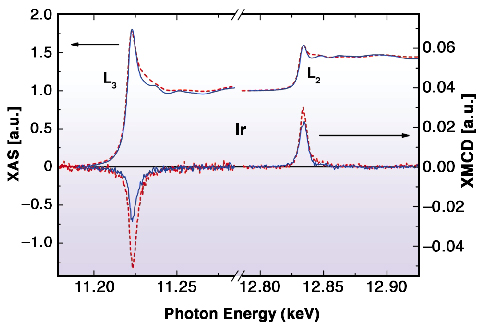- Home
- Users & Science
- Scientific Documentation
- ESRF Highlights
- ESRF Highlights 2004
- X-ray Absorption and Magnetic Scattering
- Influence of the Interface Structure on the Induced Moments in Multilayers
Influence of the Interface Structure on the Induced Moments in Multilayers
In recent years, much work has been done on the magnetic circular dichroism in X-ray absorption (XMCD) spectroscopy in various ferromagnetic multilayers and nanostructures driven by recent technological advances in magnetic recording and data storage. It has been shown recently that the spin and orbital magnetic moments at the interfaces could differ greatly from those observed in the bulk materials [1]. However, few studies have been dedicated to understanding the relation between the local structure at the interfaces and the induced magnetism. Using the inherent element and orbital specificity of XMCD, we have investigated the influence of interfacial structure on spin and orbital magnetic moments acquired by non-magnetic atoms.
Here we present the results of the XMCD study of induced 5d magnetic moments of Ir in Fe/Ir multilayers. Fe/Ir multilayers have been shown to exhibit different strained structures depending on the thickness of the Fe layers[2]. For the present study we have selected two multilayers: Fe(10 Å)/Ir(6 Å) and Fe(30 Å)/Ir(6 Å). X-ray diffraction analysis [2]shows that in these high quality monocrystalline multilayers, the Fe layers grow in body centred tetragonal (BCT) and body centred cubic (BCC) structures for the thin and the thick layers, respectively. Moreover, following the Fe phase, the Ir layers were also found to be strained and they adopt either BCC or BCT structures.
 |
Fig. 121: Normalised XAS (top) and XMCD (bottom) spectra measured at the L2,3 edges of Ir in Fe(10Å)/Ir (dashed line) and Fe(30Å)/Ir (full line). |
The experiments have been carried out at beamline ID12 using the total fluorescence yield detection mode. X-ray absorption and XMCD spectra at the Ir L2,3-edges for both samples are reproduced in Figure 121. Since the thickness of the Ir layers is kept constant in both samples, we are confident that the variation of the XMCD spectra, displayed in Figure 121, directly reflects the effect of the Fe layer structure on the induced magnetic moment carried by the Ir atoms. The very high quality of the experimental data allowed us to quantify the observed changes by applying magneto-optical sum rules [3]. In order to determine experimentally the number of holes in the Ir 5d shell, we have applied the procedure described in Ref. [1]using Au L2,3 X-ray absorption spectra as the reference. The experimental values of the Ir 5d magnetic moments (spin, orbital and total) as well as the ratio of the orbital to spin moments for the two multilayers studied are summarised in Table 1.
 |
| Table 1: Spin, orbital, their ratio and the total magnetic moment of Ir in Fe(30 Å)/Ir and Fe(10 Å)/Ir extracted from XMCD data. |
We found that for both samples the Ir spin and orbital moments are parallel, as one would expect for an atom with more than a half-filled 5d shell. The most interesting result is that the induced orbital moments of Ir change drastically with the structure of the Fe layer. The Ir 5d orbital to spin moments ratio is bigger by more than a factor of 5 for the BCT Fe layer with respect to the BCC layer. This observation clearly indicates that the intra-atomic spin-orbit coupling is not always a dominant interaction in induced magnetism and that the interfacial structure distortions play a crucial role. The influence of various structural factors on the ratio µL/µS in polarisation of "non-magnetic" 5d transition metals certainly requires further experimental investigation. Moreover, the local structure have to be carefully taken into account in modern ab initio calculations in order to elucidate a realistic mechanism responsible for induced magnetism and, therefore, for macroscopic magnetic behaviour of multilayered structures.
References
[1] F. Wilhelm et al., Phys. Rev. Lett. 87, 207202 (2001).
[2] S. Andrieu et al., Phys. Rev. B 52, 9938 (1995).
[3] B.T. Thole et al., Phys. Rev. Lett. 68, 1943 (1992); P. Carra et al., Phys. Rev. Lett. 70, 694 (1993).
Principal Publications and Authors
N. Jaouen (a), F. Wilhelm (a), A. Rogalev (a), J. Goulon (a), J.M. Tonnerre (b), S. Andrieu (c). J. Magn. Magn. Mater. 272-276, Supplement 1, E1615 (2004).
(a) ESRF
(b) Laboratoire de Cristallographie, CNRS, Grenoble (France)
(c) Laboratoire de Physique des Materiaux, CNRS, Nancy (France)



